|

Crosses,throuighout
the ages, have played a major role in Ethiopia religious,
cultural and social life, and the cross has emerged as
perhapes the country's most important, and most decorative,
artistic emblem.
Crosses were first depicated on Aksumite coins, dating
back, as we saw in a previous article,from as early as
the fourth AD. such crosses, wihich were struck in gold,silver
and bronze for several centuries, took the form of a simple
equal-armed Greek or Roman cross. These were almost certainly
the first crossess to com, and to be displayed and worn,in
Ethiopia. Ethiopia craftsmen, however, soon began producing
increasingly intricate, and complicated crosses, which
in the cource of time developed a uniqe character, and
symbolism, of the own. Various features of the cross,
and it is often elaborate detail, came to be endowed with
subtl religious meaning, which have thus said to represent
the Trinity and the nature of God; others such subjects
as the sufferings of Chist,the Twelve Apostles,and the
Four Gospels.
Not
a few Ethiopian crosses, which have survived to the present
time, are associated with specific historical rulers of
the past. a fine processional cross at Lalibala is beleved
to have personally belonged to the twelfth century ruler
of that name , while another, at the monastery of Dabra
Nagwadgwad, is said to have been presented to it by the
great, if fanatical,centralising Emperor Zar'a Ya'qob
.
At least five basic types of cross are to be found in
Ethiopia . Each of them has evolved in innumerable, and
remarkably different,forms.
Processional
Crosses
The largest, and, in the opinoin of many, the most impressive
of all Ethiopian crosses, are of processional crosses,
so named becouse they ware held above the heads of the
crowds in church processions.
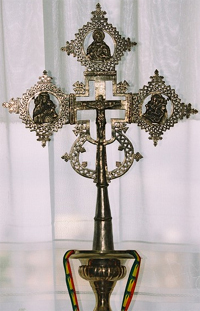 Advanced
Such crosses were used in the blessing of churches, and
of congregations, and were a prominent sight when,carried
by the clergy in their gorgeous vestments, they were taken
around the countryside great religous occasion, including
important saints' days. Advanced
Such crosses were used in the blessing of churches, and
of congregations, and were a prominent sight when,carried
by the clergy in their gorgeous vestments, they were taken
around the countryside great religous occasion, including
important saints' days.
Ethiopian
processional crosses, not a few notable examples of which
can be dated to at least the twelfth century, comprais three
basic features: the basic cross itslelf; a hollow shaft,
which enabled it ot be mounted on a wooden pole, or handle;
and two lower arms, which served to hold a piece of cloth
also carried in procession. Processional crosses were generally
made of brass, silver, or wood.some were also gilt, and
a few, in the very richest churches or monasteries, were
of gold. The
basic design of the processional crosses, irrespective
of the material out of which it was fashioned, was that
of an often highly elaborate, and Ethiopianised, Greek
or Latin cross. In many cases it had flared arms, the
lower one being often enlongeted to form the part of the
above-mentioned shaft. Many crosses were also embellished,
with strip-placing at the centure, and/or an endless variety
of fininals.
Though all crosses were of course cruciform in conception,
many processional crosses gave the appearance of other
forms. Some were thus almosr entirely round, and others
diamound-shaped. others again, particulaely characteristic
of the Lalibela period, were enclosed in an elongated
pear-shaped frome, almost like a higly decorated leaf.
Not a few processional crosses were further embellished
with incised pictures, represention Biblical personages
or scenes, the Virgin Mary and Child, for example, or
St George. some processional crosses were also incised
with short inscriptions specifying for whom, or even when,
they were produced.
|
|
Hand
Crosses, or Priests' Crosses |
|
|
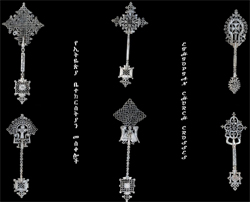 Hand
crosses,.
which were considrably smaller, if more numerous,
than processinal crosses, were carried by priest.
The latter were indeed seldom to be seen without
such a cross in thier hand, or tied round their
neck. On meeting the faithful they would hold such
a cross to the faithful, who, seeking blessing,
would kiss it ritually, in many instances with great
fervour. Hand
crosses,.
which were considrably smaller, if more numerous,
than processinal crosses, were carried by priest.
The latter were indeed seldom to be seen without
such a cross in thier hand, or tied round their
neck. On meeting the faithful they would hold such
a cross to the faithful, who, seeking blessing,
would kiss it ritually, in many instances with great
fervour.
Hnad crosses were generally mad of silver, iron,or
wood, and, being smaller than processional crosses,
tended to be less elaborate. They consisted in essence
of the cross itself, and, beneath it, a long slim
handle, by which it was held, and which linked it
to a base. This took the form of a solid cube, or
a flat rectangular plate, which might sometimes
be incrised with the name of the owner, but seldom
with anything more.
Some hand crosses had neatly worked leather sheaths
in which they would be kept, when not in service.
Hand crosses, in the prossession of religious personalities,
are from time to time despicted in traditional Ethiopian
church mural or manuscript paintings. Such visual
representations are historically important in that
they assist in identifying the type of cross ued
at various epochs of Ethiopian history.
Ethiopian
Neck Crosses
for over 1600 years Christian
Ethiopians have worn neck crosses as a proud confession
of their faith. An Amhara women of Lalibela wears
a cross typical of that region, hanging on a blue
cotton corsd called a mateb which she received at
baptism.Lalibela, the capital of Ethiopia in the
tenth century,was named after king Lalibela who
was responsible for building the 13 rock-hewn churches
for which the town is now famous.
Ethiopia crosses, usualyly named sfter towns or
provinces of the highlands, are either cast by the
lost wax method or cut directly from a Maria Thresa
dollar. The olderst are of simple Greek or Latin
design. those with flared arms show the the infulance
of Coptic crosses from upper and lower Egypt; others
probably under Celtic infulance, developed trefoils
or decorative projections. With the ready supply
of silver in the nineteenth century, the crosses
become more elaborate: complicated openwork designs,or
patterns of endless interwoven lines symbolizing
eternity became popular. Additional hinges and crowns
show the influence of nineteenth century European
medals. The star of David is worn by the Falasha,a
small group of Jewish settlers living near Gonder.
The four birds repesents the doves of peace.
|
|
|
|
|
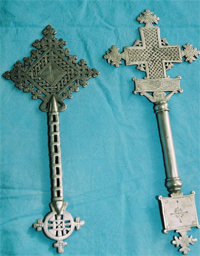 Pectoral,
or neck crosses, which were suspended from the necks of
the faithful ,were infinitely than the two other types
of cross above described. Pectoral,
or neck crosses, which were suspended from the necks of
the faithful ,were infinitely than the two other types
of cross above described.
Pectoral crosses were generally tied round their owner's
neck with a piece of blue thread or cord, called a madab,
which was sometimes give to the wearer at baptism. This
latter custom reputedly dated back to the time of Emperor
Zar'a Ya;qob, who in the course of his struggle against
animist and other beliefs, forcibly decreed that every
Christian should wear a cord of this kind .
More
to See |
|
 Such
crosses, in addition to the basic cross, generally also
had a ring, attached to the upper arm. in some instances
separated from the rest of the cross by a hinge, Most
crosses were solid,but others were hollow, and had a hinged
back that could be opened to insert a loket, which was
often highly prized. Other crosses had an additional functional
use, the lower arm being extended into a tiny spoon, known
as a kuk mawcha, which served for the extraction of wax
from the ear. Such
crosses, in addition to the basic cross, generally also
had a ring, attached to the upper arm. in some instances
separated from the rest of the cross by a hinge, Most
crosses were solid,but others were hollow, and had a hinged
back that could be opened to insert a loket, which was
often highly prized. Other crosses had an additional functional
use, the lower arm being extended into a tiny spoon, known
as a kuk mawcha, which served for the extraction of wax
from the ear.
More to See |
|
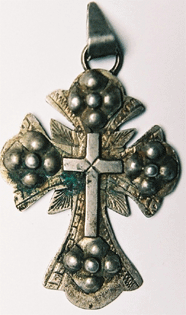 Such
crosses, in addition to the basic cross, generally also
had a ring, attached to the upper arm. in some instances
separated from the rest of the cross by a hinge, Most
crosses were solid,but others were hollow, and had a hinged
back that could be opened to insert a loket, which was
often highly prized. Other crosses had an additional functional
use, the lower arm being extended into a tiny spoon, known
as a kuk mawcha, which served for the extraction of wax
from the ear. Such
crosses, in addition to the basic cross, generally also
had a ring, attached to the upper arm. in some instances
separated from the rest of the cross by a hinge, Most
crosses were solid,but others were hollow, and had a hinged
back that could be opened to insert a loket, which was
often highly prized. Other crosses had an additional functional
use, the lower arm being extended into a tiny spoon, known
as a kuk mawcha, which served for the extraction of wax
from the ear.
More to See |
|
 Such
crosses, in addition to the basic cross, generally also
had a ring, attached to the upper arm. in some instances
separated from the rest of the cross by a hinge, Most
crosses were solid,but others were hollow, and had a hinged
back that could be opened to insert a loket, which was
often highly prized. Other crosses had an additional functional
use, the lower arm being extended into a tiny spoon, known
as a kuk mawcha, which served for the extraction of wax
from the ear. Such
crosses, in addition to the basic cross, generally also
had a ring, attached to the upper arm. in some instances
separated from the rest of the cross by a hinge, Most
crosses were solid,but others were hollow, and had a hinged
back that could be opened to insert a loket, which was
often highly prized. Other crosses had an additional functional
use, the lower arm being extended into a tiny spoon, known
as a kuk mawcha, which served for the extraction of wax
from the ear.
More to See
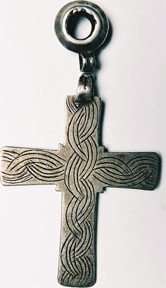
|
|




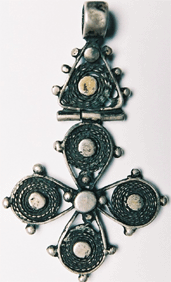


 Advanced
Such crosses were used in the blessing of churches, and
of congregations, and were a prominent sight when,carried
by the clergy in their gorgeous vestments, they were taken
around the countryside great religous occasion, including
important saints' days.
Advanced
Such crosses were used in the blessing of churches, and
of congregations, and were a prominent sight when,carried
by the clergy in their gorgeous vestments, they were taken
around the countryside great religous occasion, including
important saints' days.





